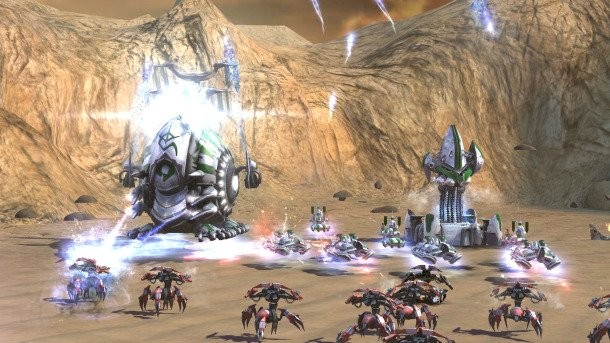Please support Game Informer. Print magazine subscriptions are less than $2 per issue
Supreme Commander 2 Afterwords

The latest release from Gas Powered Games goes down a road rarely traveled by sequels. Lead designer/studio head Chris Taylor explains why Supreme Commander 2's design is so different than the original in this Afterwords feature.
SupCom 2 makes more changes to the core design of the original than most sequels. What was the thinking behind approaching it that way, and how do you feel about the results?
We stepped back, took a look at the first game and asked ourselves, "What did we do right? What can use improvement?" We knew the economy wasn’t working as well as we had hoped and in simple terms was keeping some people from embracing the game, so that went on the list. We also knew we had too many units, and more importantly, units that are built early in the game weren't much use later on, so the tech tree was born to keep these units relevant. We also wanted to take the game to the next level visually, and so we built a new rendering engine. Every decision we made had solid thinking behind it, and now that we can see the final results, I couldn’t be happier with the way it all came together.
What made you decide to bring the economy model more into line with RTS genre norms (pay upfront instead of resource drain, reduced emphasis on continual mass/energy production expansion)?
As much as we loved the old model, we knew we needed something that more people could jump into and play. We still have some very cool ideas, like the auto-repeat button that will allow factories to continually churn out units, and you can queue up units before a factory is even finished building.
In the end, what do you like and dislike about the changes to the economy model?
I think that overall it’s a huge win. The only challenge we have is when you run out of money and your factories auto-pause because they can’t keep paying for the units. It’s the only wrinkle we’ve run into, but it’s pretty small in the big scheme of things.
RTS has never been a genre renowned for its storytelling, but you put story out there as one of the things you were focusing on for this game. What do you think did and didn't work about the story presentation in SupCom 2?
Well, I think from here on out, we’ll get better and better at the storytelling. It’s tough because most of our fans say they don’t care, but deep down, we know they care. So we try and strike a balance. One of the cool things we did was to tell the story while the game is actually playing, so players aren’t held up to watch a big cutscene. And we now do our entire mission briefing right in the engine…so it immerses the player in the fiction more. It’s been a huge step up for us, and I think we struck a nice balance in how it’s presented.
Smaller multiplayer maps are a disappointment to many fans. What was the reasoning behind that, and how do you feel about the change?
It’s all about how we manage the computer’s resources. This time we are providing a range of maps, and some of them are still quite large. We might have gone overboard on the original game, but this selection is much more in line with what we believe most people are looking for.
The research/tech model is unusual. Why did you go with this design, and how do you think it ultimately worked out?
Our experience, and mostly through playtesting, shows us that people really love this new model. It adds depth, it adds replayability, and it gives the game a much broader range of strategic possibilities. It’s harder to see the clear winning strategy, and that’s exactly what we want.
Do you miss anything about the old tech-1/tech-2/tech-3 paradigm?
No, and I’m not proud of that design. It sort of evolved out of the old Total Annihilation model, which worked for two tiers, but I felt started to fall apart at three tiers. This new approach is clean, it’s much easier to play, and the focus is on the strategy, not remembering to click and upgrade all your extractors.
Developing the 360 version in-house is a change for GPG. How did that affect the development process?
Well, it’s a lot of work, but it was totally worth it. We designed and implemented a brand new UI system and now have a much better understanding of what it takes to make a console title. We’re pretty darn confident that we have finally brought large-scale RTS gaming to the console!
If you could pick one thing, right now, that would be added or subtracted for Supreme Commander 3, what would it be?
I know this is a trick question, but I’ll answer it anyhow. I think we can push the strategic mode UI a lot further. After you’ve played with the 360 and the new “Paint Attack” system, you see a lot of new possibilities. We actually brought that over to the PC, and it’s wickedly fun. We have so much more to explore in this area, and I know that we’ll continue to evolve and advance RTS gaming. It’s such a great genre!










